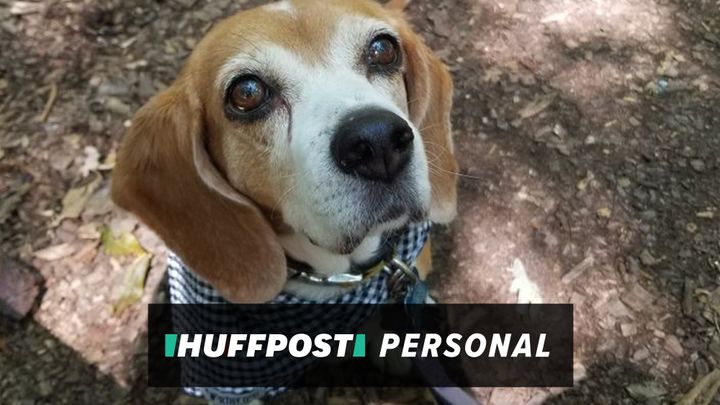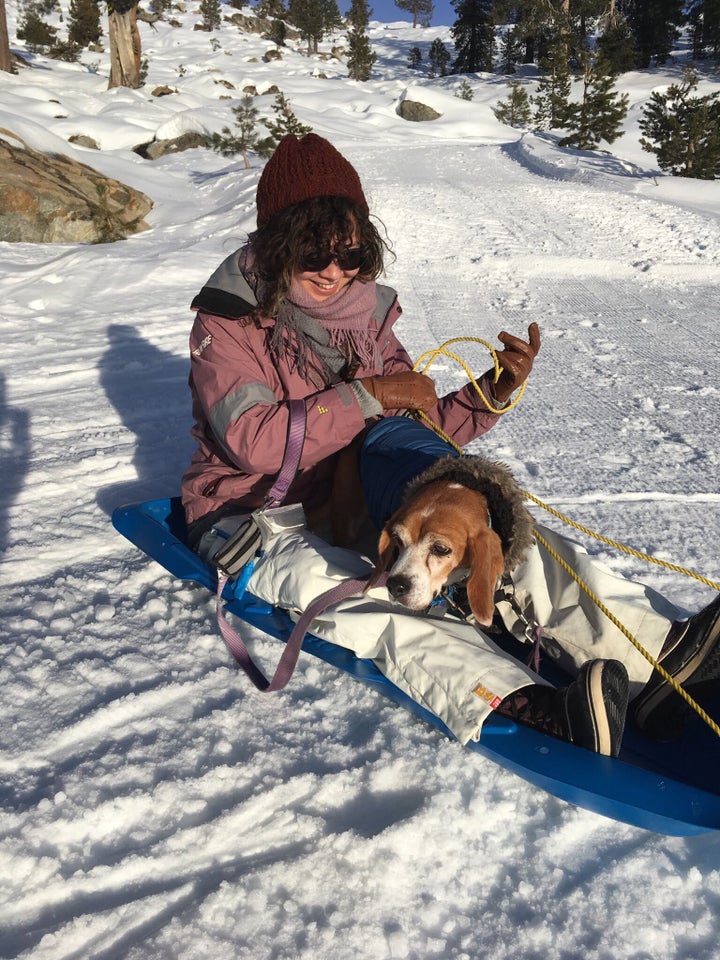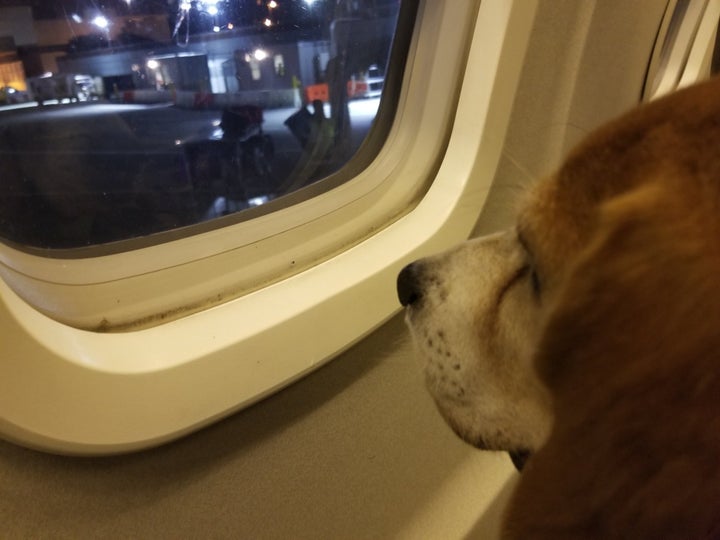
Shiloh, the nine-year-old beagle I’ve had for over a year, is not a service dog. A lot of people make that assumption, but she is actually an emotional support dog.
That means you might find that looking into her big doe eyes makes you feel a little better. But she makes it possible for me to manage my life, the good days and especially the bad ones.
An emotional support animal (ESA) – typically a dog or a cat – provides psychiatric or therapeutic support for a person with a disabling mental illness.
In 2015, I was diagnosed with an anxiety disorder and post-traumatic stress disorder. Later my therapist revised my diagnosis to complex post-traumatic stress disorder. CPTSD means I experienced “chronic trauma that continues or repeats for months or years at a time.” According to my therapist, my disorder stems from being abused by a boyfriend in my late teens and early twenties and is complicated by my early childhood trauma.
Everyone’s symptoms are different. Mine usually manifest as nightmares, frequently the same one. I am back in that abusive relationship. All that I did to leave and build a good life has vanished. I am back feeling small, helpless and violated. It’s like a bad movie. I am confused and swear this cannot be right. There must be a mistake. I wake up in a cold sweat, my heart beating as if about to take flight.
“An emotional support animal ― typically a dog or a cat — provides psychiatric or therapeutic support for a person with a disabling mental illness.”
It takes me a minute to realise where I am. I practice some of the grounding techniques learned from my therapist. I pay attention to what I can feel: the sheets on my skin, the pace of my breath, my sweat-soaked hair sticking to my face. I remember I’m not back there anymore. Even though it has been ten years, it still feels like I left yesterday. My entire body carries the physical trauma of years of emotional and sexual abuse. Often I can snap out of it. But not always.
On mornings when I can’t, I remain inert in bed. I have had to miss work.
When I’m triggered in public – if a classmate in a graduate school seminar, for instance, talks bluntly about rape – I can feel myself disassociate. My body may be sitting in the chair, but my consciousness has slipped out and is floating above the classroom. I excuse myself to go to the bathroom. I know I’ve lost participation points and missed course material when I “go away.”
When my therapist brought up the possibility of an emotional support dog, I was intrigued. I am a stop-to-pet-every-dog-on-the-street person and I grew up with dogs, so it was a comforting thought to have one around. Because my mother already had a small dog that was prescribed as an ESA for her anxiety, I was also familiar with the concept. As I read up more fully on what ESAs are and how they differ from service animals, it made sense that this would be the right thing for me.
Ever since I was a child, I knew I would someday adopt a rescue beagle and name it Shiloh, after the dog in Phyllis Reynolds Naylor’s children’s book. One month before my 30th birthday, I finally got the chance.

Shiloh is squat and timid with a brown, black and white coat – what they call a tri-colour beagle. When I look at her white, heart-shaped face, my body fills with joy – just like yours probably does with your dog.
However, Shiloh is more than a pet. When I hold onto her, she fills up my whole mind, so much so that the bad memories and the bodily symptoms from CPTSD become bearable. Since Shiloh came home with me, I have had fewer nightmares and triggering episodes. When they do happen, I can go over to her crate, wake her from her sleepy-dog haze and cuddle her in my lap. I remind myself that I am safe. Petting her calms me down.
After one flashback this past summer, I sat on my bedroom floor hugging her while I reminded myself over and over again that I wasn’t in that abusive relationship anymore. I felt physically ill, my heart was pounding and my anxiety was causing tunnel vision. Shiloh stayed in my embrace, while her warm body helped me to find a way back to the present.
As numerous studies have shown, ”dogs make people feel good.”
When I was looking to adopt an ESA, I knew I needed an animal that could travel with me. At the time I was in a long-distance relationship, visiting my husband in North Carolina; it was my second home. So I needed an ESA that could fly with me fairly often – about once a month. That meant an older dog, smallish and even-tempered. When I first met Shiloh, she was a small, older beagle staying with a foster family in Efland, North Carolina. She was perfect.
“Shiloh is more than a pet. When I hold onto her, she fills up my whole mind, so much so that the bad memories and the bodily symptoms from CPTSD become bearable.”
Before I can fly with Shiloh, I have to get three forms filled out for the airline: one from a medical or mental health professional about my illness, one from the veterinarian verifying Shiloh’s vaccinations and one by me testifying that she has been trained to behave properly in public. This process can take a few weeks and the forms have to be sent to the airline for approval at least 48 hours before travel. Fortunately, the completed forms can then be used for up to one year.
I was nervous to fly with Shiloh the first time because of the disparaging comments about ESAs that I’ve seen on TV and social media. Many news stories covered only the negative aspects of flying with uncrated animals – incidents of people lying about having an ESA or bringing an untrained animal aboard a flight. Even though traveling with Shiloh is now part of my life, I still wonder each time how strangers will react.
Thankfully, over about a half dozen trips on two different airlines – Delta and United – Shiloh and I haven’t had any real issues. It’s true that some airline employees know what an ESA is, while others seem completely baffled when I walk to the check-in counter or gate. But the most difficult part of flying has been ordering a ride to get me to the airport. Uber and Lyft don’t have an option to specify that I’m traveling with an animal, so I have to call each driver to see if it’s OK. Most drivers are fine as long as I keep Shiloh in a duffle bag to keep dog hair from getting on the seats, although I have had drivers cancel.

Flying itself can be a stressful experience. Shiloh helps keep me calm going through security and during turbulent flights. If I’m traveling for more than a few days, I need her to be wherever I’m staying so that I can best manage any CPTSD symptoms.
She also brings a bit of comfort to my fellow travelers as we wait in airport purgatory together. Generally, everyone is grumpy and annoyed over the long security lines, the mandatory taking off of their shoes and the delays that seem to last a lifetime until the plane finally shows up. Yet I’ve seen people’s faces light up in smiles when they see Shiloh in the boarding line.
She’s quiet for a beagle. Often, fellow passengers will look over surprised and say, “Oh, you have a dog? I didn’t even realise.”
I have yet to encounter anyone with a negative response to Shiloh when I travel with her.
“She also brings a bit of comfort to my fellow travelers as we wait in airport purgatory. ... I’ve seen people’s faces light up in smiles when they see Shiloh in the boarding line.”
Too many times I’ve watched a television show where someone with an ESA is the punch line of the joke. The character is framed as if they’re being overly dramatic and just can’t handle life. I wish I were just being dramatic when I disassociate or am consumed by a flashback in which my abusive ex continues to violate me. Emotional support animals aren’t a joke. Shiloh keeps me grounded.
During especially bad bouts of depression when I can barely get out of bed in the morning, having Shiloh has made such a difference in my life. Feeding her reminds me that I should also eat. Having to take her outside for a walk keeps me from locking myself in my apartment all weekend. Depression makes many small tasks seem like an unbearable effort. But when Shiloh looks up at me with that goofy grin and wags her tail, I find I am not alone in my depression.
Next time you see someone traveling with an animal that isn’t in a crate and isn’t marked as a service dog, consider the possibility that you’re looking at an emotional support animal. Assume the person needs that dog or cat to travel safely. Say hi if you want, but please ask before petting the animal.
Just remember: we are all flying with our own stories.
This article first appeared on HuffPost US Personal
Have a compelling personal story you want to tell? Find out what we’re looking for here, and pitch us on ukpersonal@huffpost.com